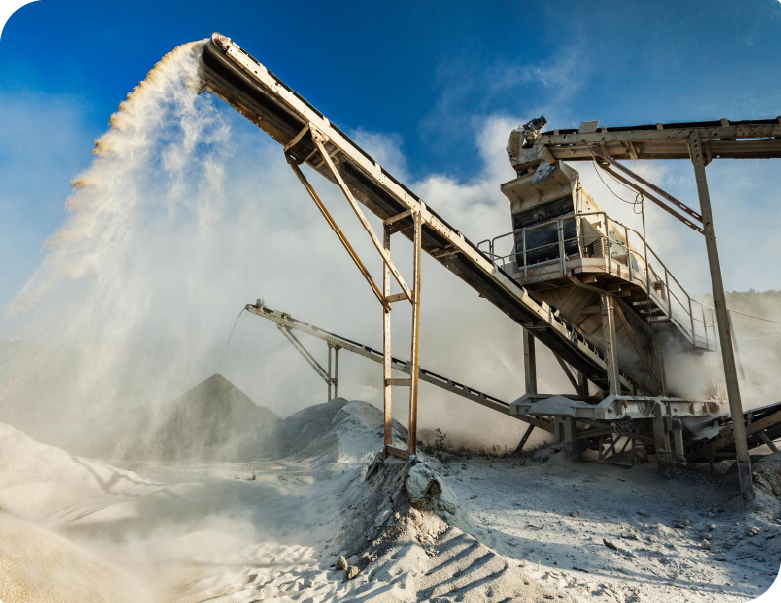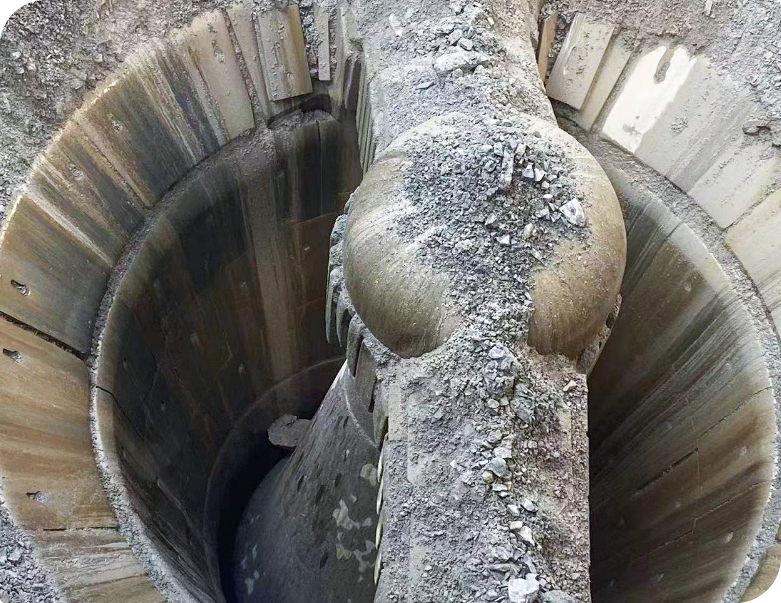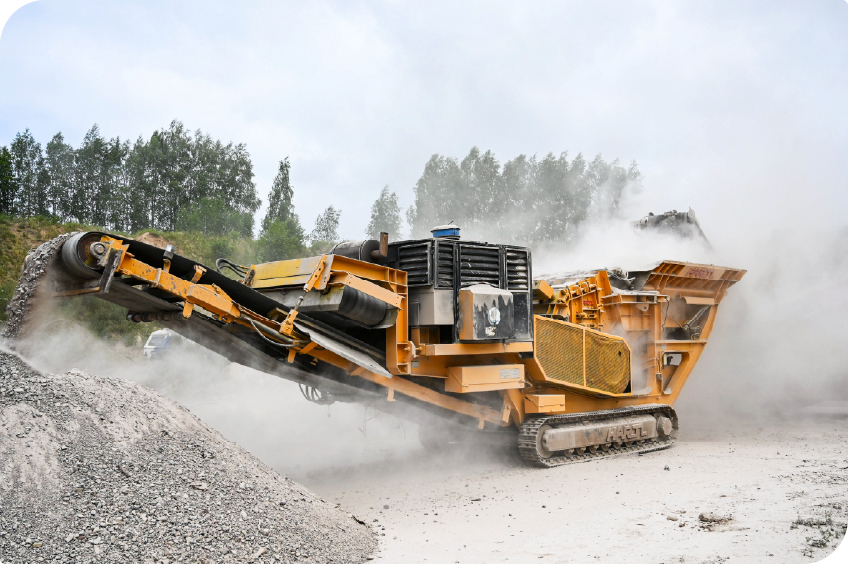Application Field
Mining sites, Metal ore crushing, etc.Gyratory Crushing
Station Liners
Liner, Gyratory Body, Mantle, Arm Guard (made of Mn14, Mn18 high manganese steel material).
Liner, Gyratory Body, Mantle, Arm Guard (made of Mn14, Mn18 high manganese steel material).

The largest crusher in the world is a gyratory crusher, which utilizes the gyrating motion of the crushing cone within the cone cavity of the shell to exert squeezing, splitting, and bending effects on materials.
It is a large-scale crushing machinery for coarse crushing various
hardness ores or rocks. As early as the 1970s, the world's largest gyratory crusher could process 5,000 tons of material per hour, with a maximum feed diameter of up to 2,000 millimeters.
Application Field
Mining sites, Metal ore crushing, etc.Application Medium
Copper ore, Iron ore, Gold ore, Tungsten ore, Tin, and other metal ores.The gyratory crusher achieves the adjustment of the discharge outlet in two ways:
One is through mechanical means, with an adjustable nut at the upper end of the main shaft. By rotating the adjusting nut, the crushing cone can descend or rise, thereby increasing or decreasing the size of the discharge outlet.
The second method is through hydraulic means, using a hydraulic gyratory crusher. The main shaft sits on a plunger inside the hydraulic cylinder, and changing the volume of hydraulic oil under the plunger can adjust the up and down position of the crushing cone, thereby changing the size of the discharge outlet.


As a commonly used primary coarse crushing equipment, the gyratory crusher has outstanding advantages, such as high production capacity, large crushing ratio of 6-9.5 (in some cases up to 13.5), stable operation, and low vibration.
Due to the vulnerability of the shredder, the wear-resistant liners have a high consumption rate. Through optimization, the service life of the liners can be extended. The focus of wear-resistant liners is mainly on the optimization design of the cavity curve and the optimization of liner materials.
The gyratory crusher is an important rough crushing equipment widely used in the mining industry.After the ore is blasted, ore with a particle size of 1,300 millimeters can be fed into the gyratory crusher through large mining trucks.
The ore is crushed within the crushing cavity to a size of less than 300 millimeters and discharged through the outlet. It is then transported by conveying equipment to subsequent crushing or grinding equipment. Therefore, there is a significant consumption of wear-resistant liners in the gyratory crusher.

| Material Grade | Main Chemical Components (Score)/% | ||||||||
| C | Si | Mn | P | S | Cr | Mo | Ni | W | |
| ZG120Mn7Mo | 1.05∽1.35 | 0.3∽0.9 | 6∽8 | ≤0.060 | ≤0.040 | - | 0.9∽1.2 | - | - |
| ZG110Mn13Mo | 0.75∽1.35 | 0.3∽0.9 | 11∽14 | ≤0.060 | ≤0.040 | - | 0.9∽1.2 | - | - |
| ZG100Mn13 | 0.90∽1.05 | 0.3∽0.9 | 11∽14 | ≤0.060 | ≤0.040 | - | - | - | - |
| ZG120Mn13 | 1.05∽1.35 | 0.3∽0.9 | 11∽14 | ≤0.060 | ≤0.040 | - | - | - | - |
| ZG120Mn13MCr2 | 1.05∽1.35 | 0.3∽0.9 | 11∽14 | ≤0.060 | ≤0.040 | 1.5∽2.5 | - | - | - |
| ZG120Mn13W | 1.05∽1.35 | 0.3∽0.9 | 11∽14 | ≤0.060 | ≤0.040 | - | - | - | 0.9∽1.2 |
| ZG120Mn13CrMo | 1.05∽1.35 | 0.3∽0.9 | 11∽14 | ≤0.060 | ≤0.040 | 0.4∽1.2 | 0.4∽1.2 | - | - |
| ZG120Mn13Ni3 | 1.05∽1.35 | 0.3∽0.9 | 11∽14 | ≤0.060 | ≤0.040 | - | - | 3∽4 | - |
| ZG90Mn14Mo | 0.70∽1.00 | 0.3∽0.9 | 13∽15 | ≤0.070 | ≤0.040 | - | 1.0∽1.8 | - | - |
| ZG120Mn18 | 1.05∽1.35 | 0.3∽0.9 | 16∽19 | ≤0.060 | ≤0.040 | - | - | - | - |
| ZG120Mn18Cr2 | 1.05∽1.35 | 0.3∽0.9 | 16∽19 | ≤0.060 | ≤0.040 | 1.5∽2.5 | - | - | - |
| Grade | Yield Strength | Tensile Strength | Elongation | Impact Capacity |
| Rp0.2/MPa | Rm/MPa | A/% | KU2/J | |
| ZG120Mn13 | ≥370 | ≥700 | ≥25 | ≥118 |
| ZG120Mn13Cr2 | ≥390 | ≥735 | ≥20 | ≥96 |
| ZG120Mn13W | ≥370 | ≥700 | ≥25 | ≥118 |
| ZG120Mn13CrMo | ≥390 | ≥735 | ≥20 | ≥96 |
| ZG120Mn13Ni3 | ≥370 | ≥700 | ≥25 | ≥118 |
| ZG120Mn18 | ≥370 | ≥700 | ≥25 | ≥118 |
| ZG120Mn18Cr2 | ≥390 | ≥735 | ≥20 | ≥96 |
Still have questions? Don't hesitate to contact us for more answers. Contact Us
What Is A Mill Liner?
A mill liner is a system of specially designed geometrical components that are installed inside a horizontal tube mill compartment to protect it from abrasion and impact wear. The geometrical design facilitates the efficiency of the ore grinding process.
How Does A Mill Liner Work?
Mill liners are designed to create a tumbling motion of the grinding balls and ore inside the mill compartment. This tumbling motion generates impacts and shifts the material towards the discharge end of the mill, creating abrasion.
The impacts and abrasion reduce the ore inside the mill from the original feed particle size to a desired discharge particle size that will enable further processing to liberate minerals or metals from the ore.
What Are The Main Types Of Mill Liners?
There are numerous types of mill liners manufactured from either metal, rubber or a combination of both (composite). Mill liners are always custom-designed to suit the specific application; the liner material is also selected based on the application and particle size.
How Do I Select The Right Mill Liner For An Application?
Selecting the right mill liner requires a combination of technical expertise and experience. Simulation software can also be used to assist in decisions on lifter face angles, heights and spacing that will generate the best charge motion to reduce the ore and efficiently use available energy.
The selection of liner materials is typically done based on knowledge relating to impact energy and abrasiveness of the material being milled. Cast alloy steels, various elastomer compounds or a combination of both may be chosen. It is best to consult with a mill liner product specialist to ensure that the most appropriate material is selected for the application.
What Type Of Fixing Arrangements Are Available For Mill Liners?
Mill liners are typically fastened into the mill compartment using bolts. Liners can be through-bolted (typical for metal liners and some composites) or secured using T-tracks and T-bolts (typical for rubber liners).
More recently, external bolting systems have been developed for metal and composite liners too. Bolts typically have cup washers and rubber seals external of the mill shell to ensure that slurry from within the mill does not leak out. This helps to prevent corrosion of the fasteners and shell components.
What Is The Lifespan / Wear Life Of A Mill Liner?
The wear life of a grinding mill liner is subjective and depends on the application, size of the mill and characteristics of the material being ground. Wear life is sometimes chosen to suit maintenance scheduling within the mill circuit too.
During the life of a liner, it is usual for wear to be monitored through visual inspection and other measurements which enable reasonable estimations to be calculated. Digital methods for monitoring liner wear are being developed too and are expected to be commercially available soon.
How Do Mill Liners Impact The Performance Of My Overall Circuit?
There is a direct relationship between mill liners and circuit performance. Poorly designed and/or selected mill liner designs can result in poor mill efficiency, equipment availability and energy consumption.
Other ways that suboptimal mill lining systems can impact circuit performance include:
Lower mill throughput;
Accelerated wear in pumps, cyclones and pipes;
Recovery losses of valuable minerals or metals (due to out-of-specification mill product in downstream processes)